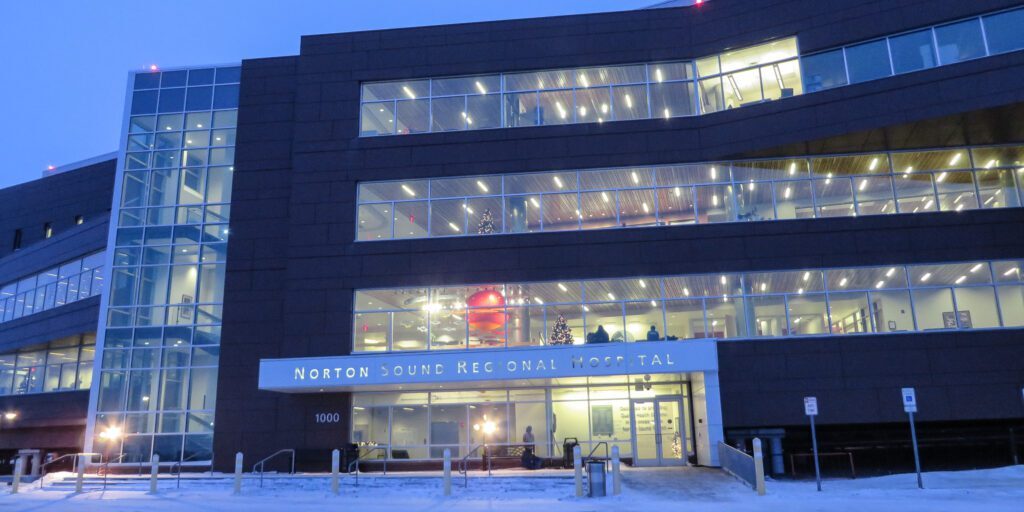Construction resumes on a regional Wellness Center which is anticipated to be open within two years (April 2021).
The multi-faceted facility currently being built in Nome will contain a sobering center, something the community and region have needed for years.
The first barge of the season arrived into Nome on the morning of Memorial Day (May 27), bringing with it much-needed materials for Norton Sound Health Corporation’s Wellness Center.
“And all that steel is for the exterior of the building. So, by, I’m going to guess, the end of October — of course, that varies with the weather — the entire exterior will be erected, and that includes the roof, as well.”
Lance Johnson, the Director of Behavioral Health Services, says once the roof is completed, then construction crews will focus on the interior of the facility, which can be finished during the winter. Originally, the wellness center was planned to be built at the old hospital building in Nome.
As is the norm with large construction projects, plans are subject to change as the building phase moves along.
For example, Johnson says due to the number of beds available at the day shelter not being enough to meet the needs of the people coming in, he has already requested a change in the capacity for the yet-to-be-built sobering center.
“Even though the sobering center will be more for folks who aren’t that ambulatory and really need that medical oversight, we just had to find a way to squeeze in a few more bed areas, recovery areas.”
The day shelter, Johnson says, will be kept separate from the sobering center, as the shelter is not just for people who have substance misuse issues or addictions. According to Johnson, some guests have nowhere else to go and would stay out on the street if the day shelter wasn’t available.
According to Johnson, people will be able to access additional treatment from either the day shelter or the sobering center, as long as each individual is ready for it.
When it comes to addressing public intoxication in Nome, Johnson likes to reiterate again and again that it is a community issue and requires a joint-community effort. Nome Police Chief Bob Estes agrees wholeheartedly.
“We were working with folks like Lance and other groups here to see what we can do to help assist folks get additional help that they need. And the wellness and sobering centers are only going to be that extra step that’s going to help us in the long term to assist folks here, so we are excited to see that.”
Though Chief Estes is excited for the benefits the sobering center will provide two years from now, he says public safety staff in Nome are already struggling with public intoxication calls.
“From this point to 2021, when that facility is supposed to open, we are still having issues here. The numbers that we were looking at in May of 2019: we had 131 calls for service for intoxicated people, and in the same time frame in 2018, we had 120 calls. So, we are seeing an uptick for calls for service, which, again, is over-taxing.”
As the wellness and sobering centers are constructed over the next two years, Estes hopes to get some local laws on the books which could help NPD prevent worse crimes, like sexual assaults.
“I know the City Manager is looking at the possibility of some type of an intoxication ordinance that could be enacted here. If you could at least take the person off the street for a 12-hour period under an ordinance, to help get those people in a sobering state, then there’s no doubt in my mind we could prevent, possibly, a more major crime from occurring.”
Currently, without an ordinance that has more teeth, or a sobering center to hold intoxicated individuals, local law enforcement’s options to address public intoxication are limited.
Chief Estes says that every incident is different, but if an individual meets the conditions of Alaska Statute Title 47, then they could be taken into protective custody. Normally, that person would be brought to a treatment facility, but since there is no sobering center in Nome, then NPD has to transport the intoxicated individual elsewhere.
Estes says NPD can bring people under the influence of alcohol, who meet the conditions of Alaska Statute Title 47, to the Norton Sound Regional Hospital for evaluation. From there, they could go to Anvil Mountain Correctional Center (AMCC) or be kept at the hospital until they are medically cleared to leave.
Estes expressed several times that he does not want to arrest every offender, but instead help them receive services and assistance as needed.
While construction on the Wellness Center re-routes traffic on Greg Kruschek Avenue this summer (see note below), both Johnson and Chief Estes hope to continue working with the Nome community to address public intoxication.
Image at top: file photo: Nome’s Norton Sound Regional Hospital. Photo: Laura Kraegel, KNOM.
A message from NSHC:
Norton Sound Health Corporation is starting construction on two new projects in Nome across from the Norton Sound Regional Hospital. These projects will close off all non-construction vehicle and pedestrian traffic on the lot south of Greg Kruschek Avenue in order to maintain a safe construction site. Pedestrian traffic is suggested to reroute down 6th Avenue, south of the Patient Hostel/Pre-Maternal Home, in order to access the hospital (see map). This routing is intended to keep minimal pedestrian traffic on Greg Kruschek Avenue. There will also be more trucking activity than normal on both building sites. The contractors have been made aware of higher volume traffic times, such as the beginning and end-of-shift times, and school drop-off and pick-up times (during the school year). If you have comments or concerns regarding the projects or suggested rerouting, please contact Mike Kruse, NSHC Project Manager, at mkruse@nshcorp.org or (907) 434-0498.




